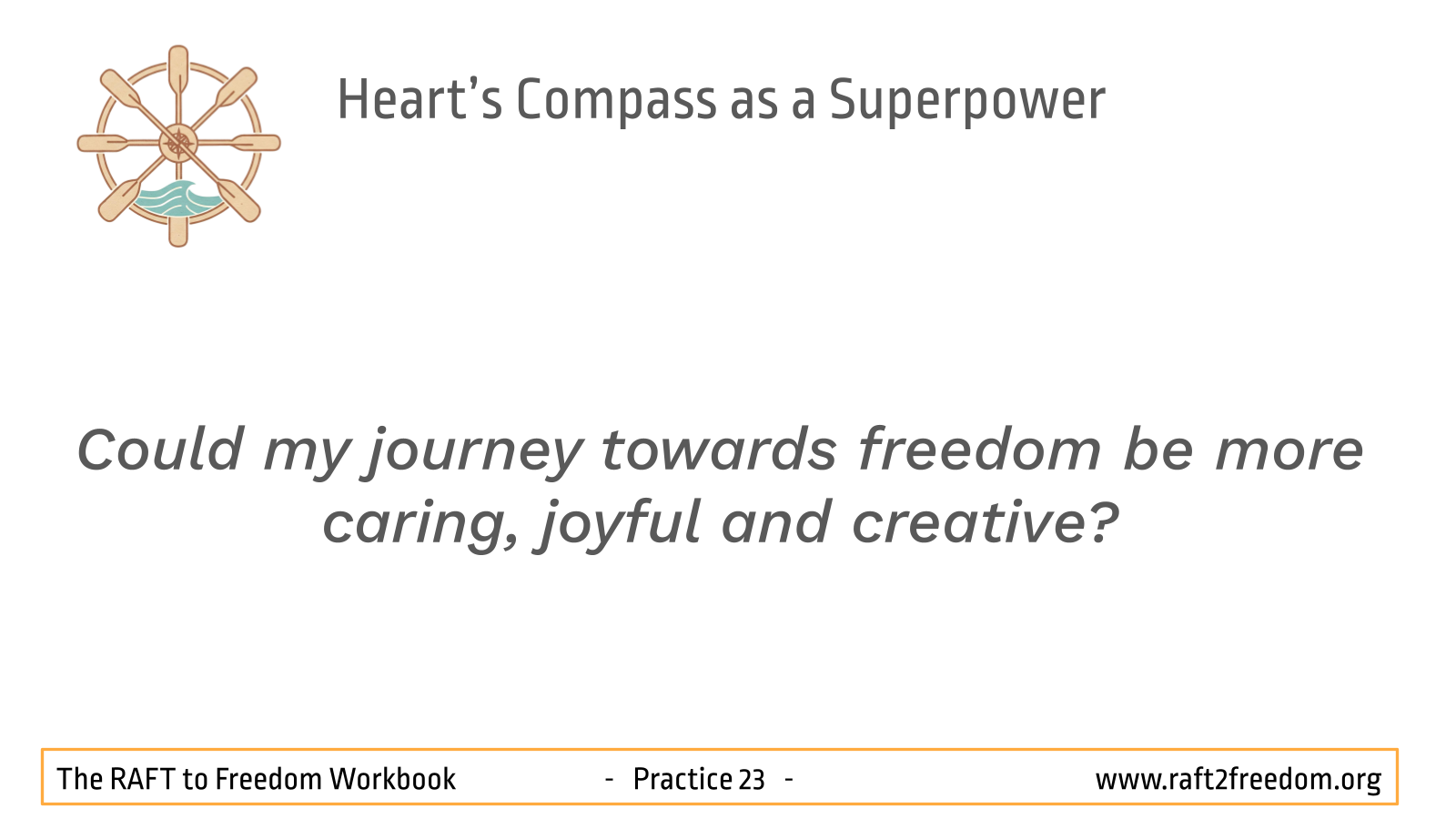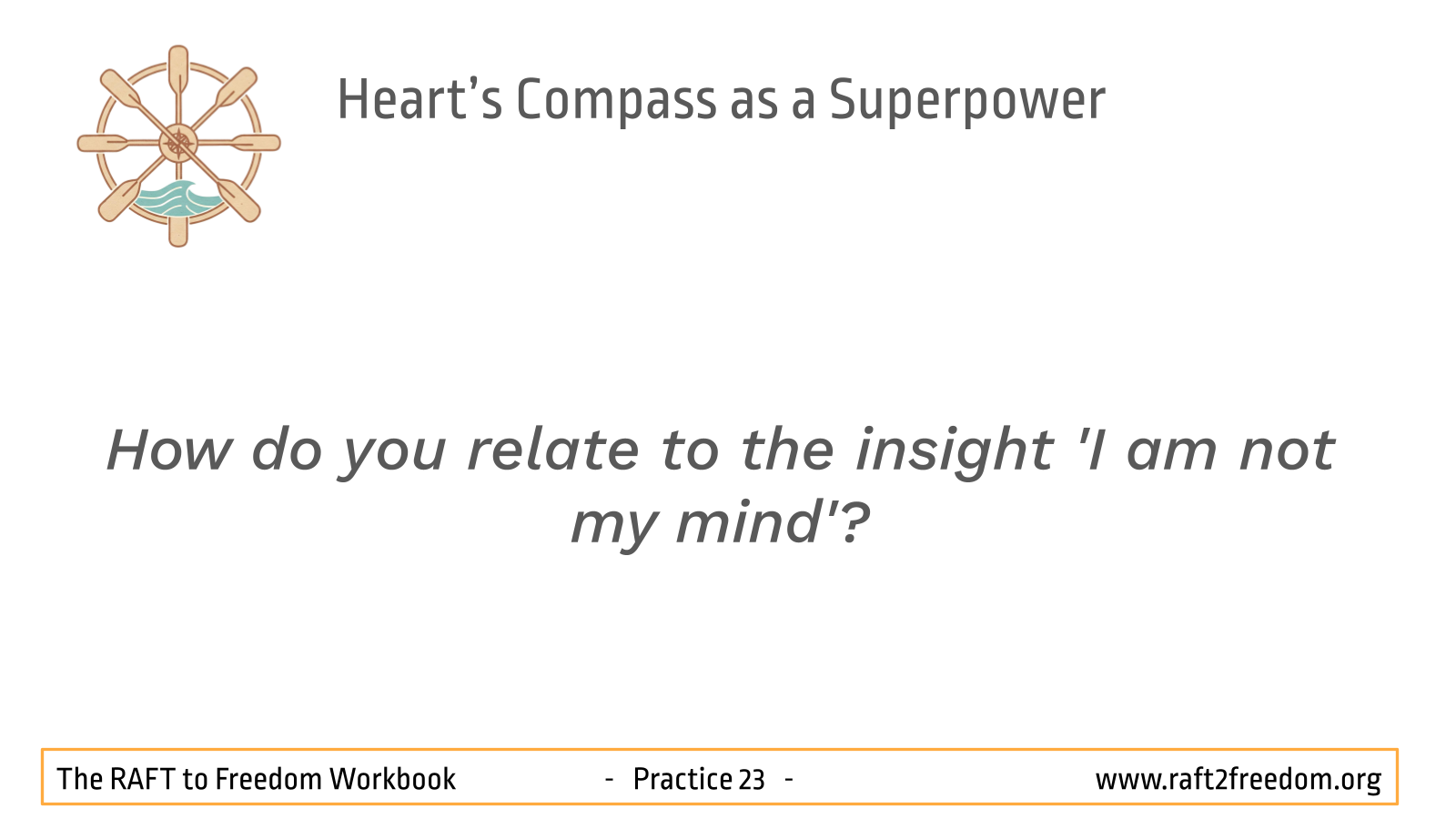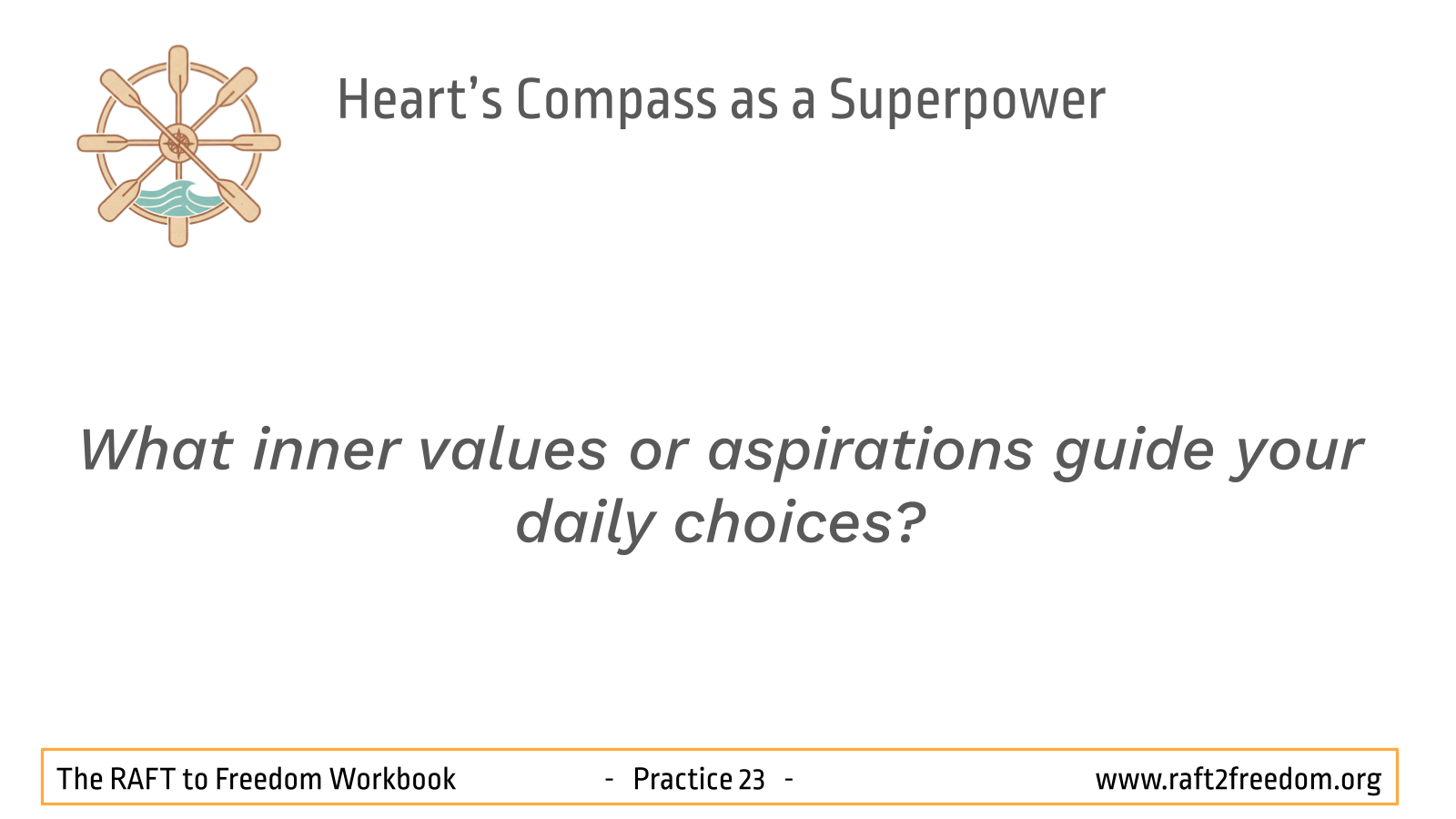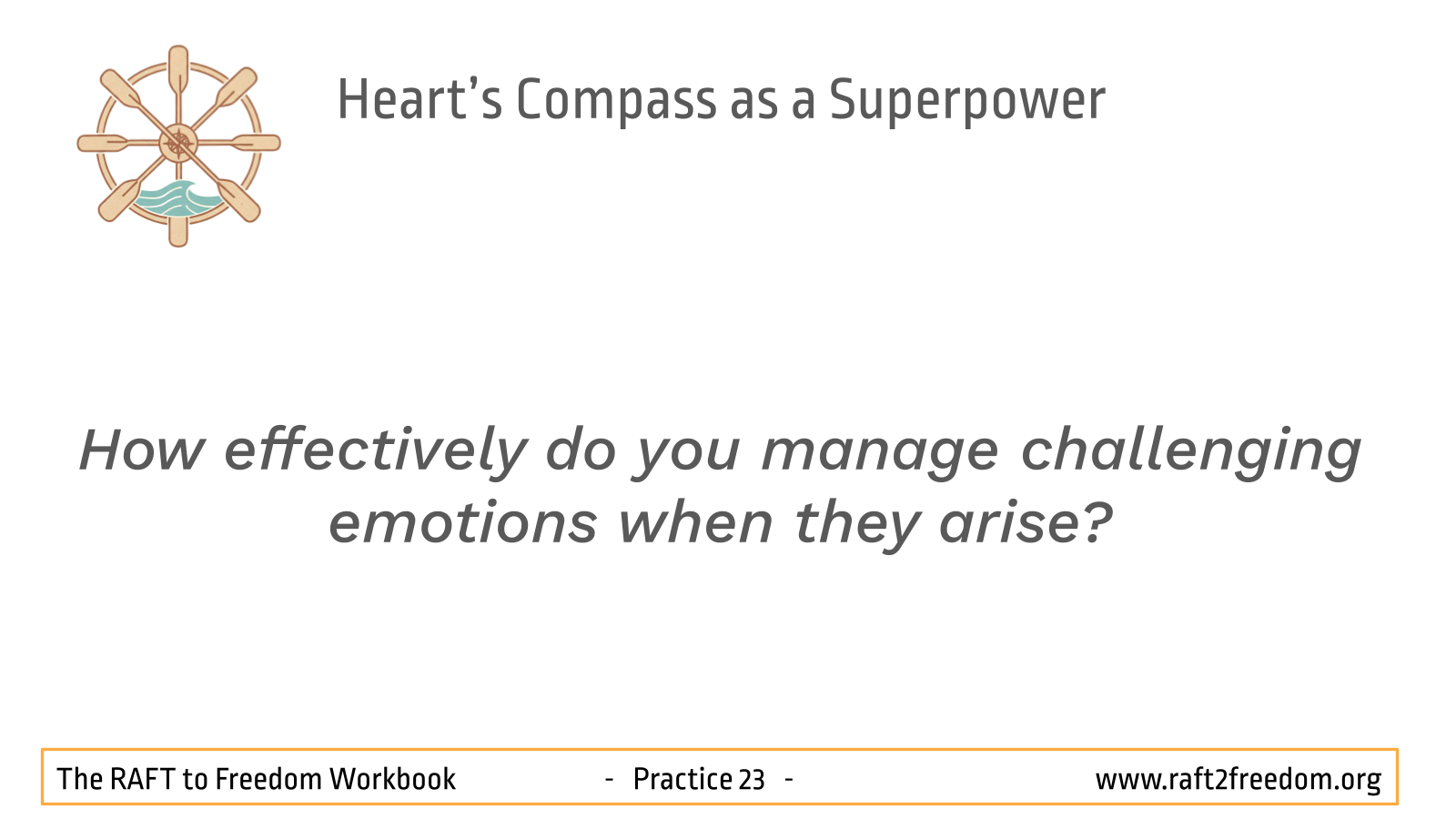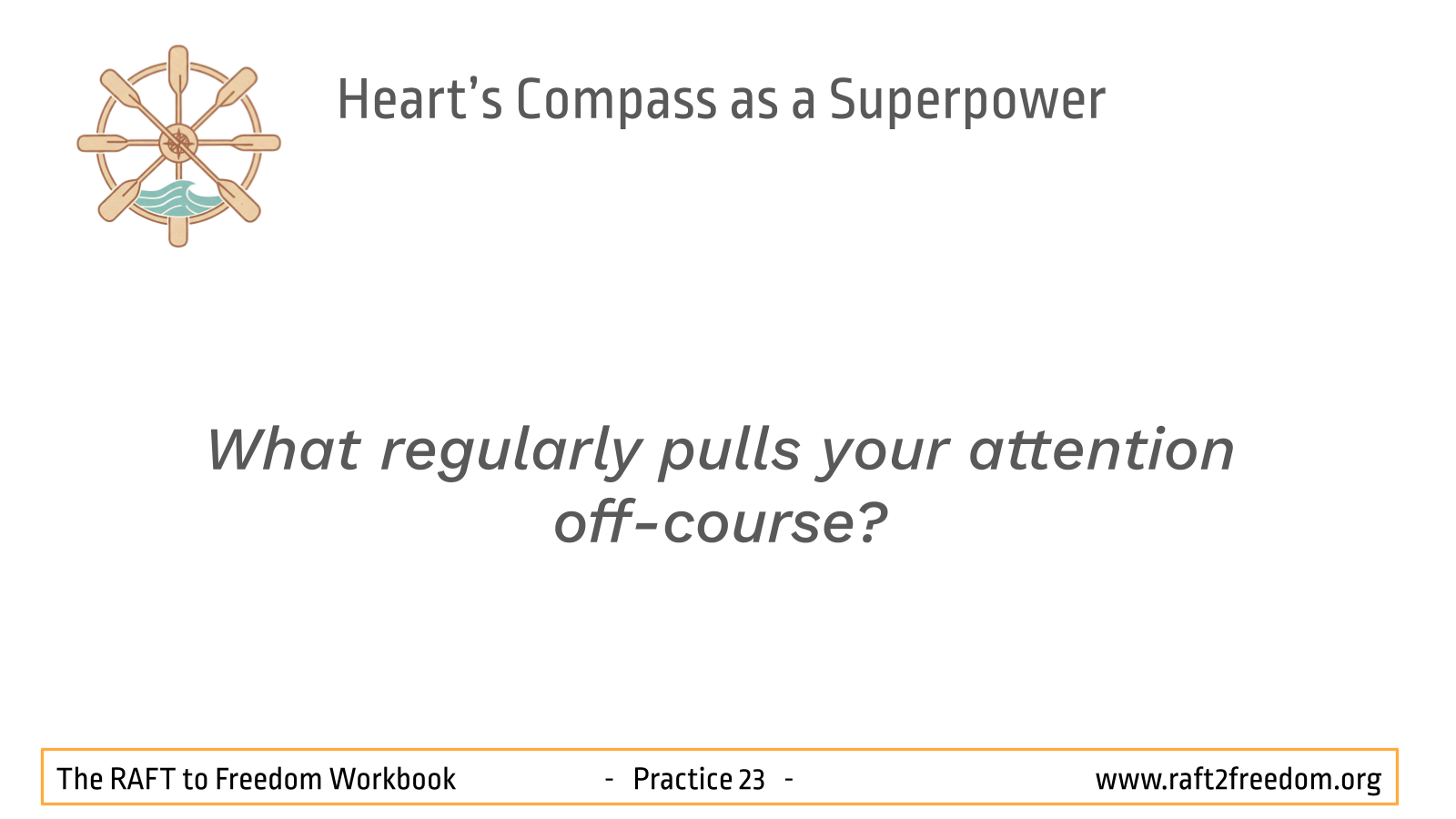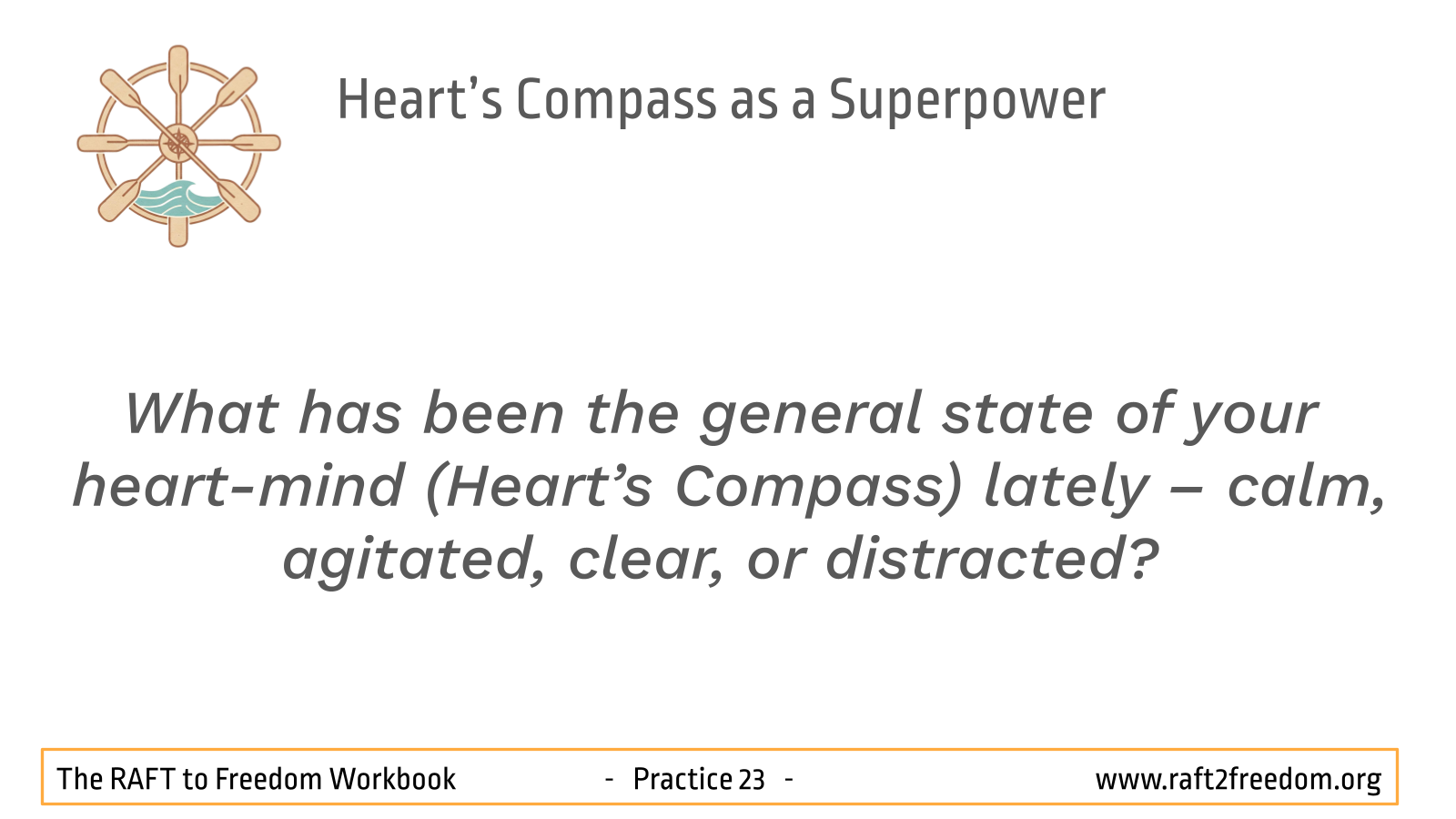23 – The Third Superpower – The Heart’s Compass
If my Heart could do my thinking,
Van Morrison
and my Head began to feel,
Would I look upon a world anew?
And know what’s truly real.
Your vision will become clear only when you look into your heart. Who looks outside, dreams; who looks inside, awakes.
Carl Jung

Episode 23 – The Heart’s Compass as a superpower
An AI generated ‘deep dive’ into this aspect of the RAFT to Freedom
Having reinforced our resolve with ‘Noble Desire’ and fuelled our journey with ‘Courageous Energy’, we now cultivate our third essential superpower: the Heart’s Compass. The Heart’s Compass works synergistically with Noble Desire, Courageous Energy, and Fearless Investigation to propel us from the suffering and danger of the ‘near shore’ to the freedom and safety of the ‘far shore’.
The Heart’s Compass (Citta) primarily represents a mindset, or state of mind that has an emphasis on the emotive side of our thinking. The Oxford English Dictionary defines citta as ‘the mind as the seat of both thoughts and feelings; (where) a person’s cognitive and emotional faculties are considered collectively’. From a Buddhist perspective the heart and the mind are connected; for the purposes of our journey, we present citta as ‘the Heart’s Compass’.
The connection between the heart and the mind – emotions and thoughts – is a universal concept. It has been said in many contexts:
“The longest journey you will ever take is the 18 inches from your head to your heart”.
The Heart’s Compass encompasses our mind and heart – our thoughts, emotions, consciousness, and deep intuitive knowing. It can be our greatest ally or our most challenging obstacle. A scattered and untrained mind, much like an untamed horse, runs wild with cravings, aversions, and distractions, pulling us off course. However, when trained and befriended, the Heart’s Compass provides us with inner stability, emotional clarity, and reliable guidance on our journey towards freedom. Buddhist teachings highlight that, although often clouded by distractions, our Heart’s Compass is inherently ‘knowing and luminous’ and capable of clarity. The personal insight that ‘I am not my mind’ can be surprisingly liberating. Our thoughts are real, but that does not mean they are true.
A thought is harmless unless we believe it. It’s not our thoughts, but the attachment to our thoughts, that causes suffering.
Byron Katie
The Secular Dharma author and teacher, Stephen Batchelor, beautifully describes the Heart’s Compass as:
Citta is that part of us which is not physical, which moves us from within. It is mind-heart … In this context, intuition works well, pointing to a kind of ‘knowing’ that is neither rational nor conceptual, but which has the capacity to arrive at insights, often suddenly.
Stephen Batchelor
In our RAFT metaphor, the Heart’s Compass acts as both a compass and a stabiliser – guiding our direction and preventing us from drifting or capsizing amidst the turbulence of harmful cravings or difficult emotions. A well-cultivated Heart’s Compass prevents our raft from drifting aimlessly or capsizing in turmoil. As we embrace this superpower, our Heart’s Compass becomes the navigating force that keeps us moving in the right direction, stopping us from wandering too far off course and bringing us back after we have drifted. Furthermore, the focused stability of our cultivated Heart’s Compass allows us to remain present and to make wise choices, even amidst the storms of harmful cravings or difficult emotions.
Key aspects of our Heart’s Compass
Understanding our Heart’s Compass involves appreciating its different facets:
- Mind and consciousness: The cognitive aspect – our knowing, perceiving, and thinking.
- Heart and emotion: The affective quality – our Heart’s Compass is coloured by emotions, brightening with wholesome states such as compassion, kindness, and joy, and darkening with unwholesome ones like craving, aversion, and confusion.
- Thought and intention: The Heart’s Compass is the source of our intentions that shape our actions and future experiences. In one of his talks, Gotama said, “Whatever one frequently thinks and ponders upon, that will become the inclination of their mind”.
- Integration: The Heart’s Compass blends our thoughts and feelings – hence ‘heart-mind’ is often a good translation.
- Trainability: The crucial aspect – our Heart’s Compass can be trained, purified, and liberated through practice. This malleability means our mind can change and adapt with new habits and practices.
As the Buddhist teacher and author, Christina Feldman presents Gotama’s insight, “Whatever you frequently think about and ponder shapes your ‘Mind’. The shape of your ‘Mind’ shapes your world”. Vince Cullen goes further suggesting: “Whatever you frequently think about and ponder shapes your ‘Heart’, and the shape of your ‘Heart’ shapes your world”. Remember, we are invited to befriend our minds rather than be at war with them. Cultivating our Heart’s Compass supports our self-awareness, emotional regulation, and long-term resilience.
Cultivating our Heart’s Compass: practices for stability and clarity
The Heart’s Compass can be effectively adapted to help us to move away from harmful compulsions. In this context, the Heart’s Compass involves developing mental clarity, focus, and a deeper understanding of our own minds. The challenge we often face is the wavering nature of our intention – we might desire to move on, but struggle to maintain consistency. The Heart’s Compass helps us by stabilising our inner resolve and providing a structured path towards liberation.
Developing our Heart’s Compass involves consistent mindfulness practice, emotional intelligence, and intentional mental training to achieve clarity and emotional stability.
- Clarifying your aspiration (‘Resolve’): Reflect daily on why you are engaged in this practice and what you truly seek. Contemplate suffering and its cessation, reinforcing your heart’s longing for freedom. Gotama’s determination under the Bodhi tree can serve as a profound inspiration.
- Practice: Write down or silently reflect on your aspiration for practice. This intention-setting strengthens the Heart’s Compass over time.
- Strengthening mental unification (‘A Gathered Mind’): The Heart’s Compass relies on a collected and gathered mind. Without focus, aspiration remains weak. Cultivate calm abiding through breath meditation.
- Practice: Dedicate 10–30 minutes to mindfulness of breathing daily. If the mind wanders, reconnect with your aspiration – remind yourself why you are practising.
- Generating inner zeal (‘Noble Desire’): The Heart’s Compass thrives on wholesome passion for the journey. Gotama emphasises Noble Desire (zeal) as a factor leading to the Heart’s Compass.
- Practice: Read or listen to inspiring teachings, Buddhist or otherwise. Reflect on the joy of practice, rather than seeing it as a duty.
- Using determination as a fuel for ‘Courageous Energy’: A resolute heart needs sustained effort. Gotama states that ‘Appropriate Effort’ is essential for the Heart’s Compass.
- Practice: Set small, daily practice commitments, such as: “I will meditate at least 20 minutes every day”. Gradually increase effort without forcing.
- Strengthening the Heart’s Compass through reflection and ‘Fearless Investigation’: Reflect on progress and obstacles in your practice. Gotama teaches that reflecting on one’s practice sharpens the Heart’s Compass.
- Practice: Keep a meditation journal to track insights and challenges. Regularly assess: “Is my heart’s desire for freedom increasing or weakening?”.
- Letting go of doubt and strengthening ‘Confidence’: Unhelpful doubt can confuse and weaken the Heart’s Compass. Strengthen confidence in Gotama’s path by reflecting on cause and effect in practice.
- Practice: Daily recollect the positive progress you have made on the journey so far. Surround yourself with wise friends who support your aspiration.
The Heart’s deep aspiration for freedom
“When the heart is closed, it leads to fear, stress, and anger. Nurturing the idea of the oneness of humanity has the effect of opening the heart.” ~ Dalai Lama and Thubten Chodron
The Heart’s Compass can truly be understood as the heart’s deep desire to awaken or the heart’s longing to move toward the end of suffering. This interpretation aligns with both the aspirational and resolute aspects of the Heart’s Compass within our Four Superpowers. It represents a wholehearted commitment – a deep, inner resolve to realise liberation. It is the unshakable determination that fuels perseverance on our journey, even through life’s challenges – the inevitable storms and troubled waters ahead.
We find support for our heart’s aspiration in Gotama’s own resolve before his awakening to how things really are. He cultivated an unyielding resolve, stating:
Let only skin, sinews, and bones remain… but I will not give up my exertion until I have attained what can be attained by human strength, energy, and effort.
Gotama
This unwavering determination reflects the Heart’s Compass as a heartfelt longing for liberation from our suffering.
When we develop our Heart’s Compass with sustained effort, it leads to the destruction of unskilful and harmful mental states that cloud or disturb our minds, causing us unhappiness or suffering. When our heart-mind is fully directed towards recognising and understanding what it is to be human, it gains unshakable power. The Heart’s Compass supports our mental steadfastness on our journey. A rightly directed Heart’s Compass becomes a powerful force for liberation.
Self-reflections
Explore the state of your own Heart’s Compass:
- What has been the general state of your heart-mind (Heart’s Compass) lately – calm, agitated, clear, or distracted?
- What regularly pulls your attention off-course?
- How effectively do you manage challenging emotions when they arise?
- What inner values or aspirations guide your daily choices?
- How do you relate to the insight ‘I am not my mind’?
- Could my journey towards freedom be more caring, joyful and creative?
Journaling prompts
Use writing to investigate and train your Heart’s Compass:
- Mind-wandering journal: Note where your mind drifts during brief meditations. Observe patterns compassionately.
- Straightening your arrow: Reflect on one persistent negative mental habit. Identify practical steps to gently shift this pattern.
- Heart’s deepest aspiration: Write freely about your deepest intention for your life and journey to liberation. Clarify your values.
- Observing thoughts: Spend five minutes labelling your thoughts without judgment. Reflect on the experience of seeing thoughts clearly.
- Intuition exploration: Recall a time intuition guided you effectively. How does intuition differ from purely logical thought?
Supporting material: scientific and philosophical perspectives
For those interested in the scientific and philosophical underpinnings of the Heart’s Compass, the following overview highlights some key connections:
- Neuroscience: Mindfulness training positively affects the brain by stabilising key attention networks and regulating emotional centres, including the amygdala, thereby reducing emotional reactivity and increasing mental clarity. Through consistent mindfulness practice, neural pathways involved in attention control strengthen, leading to enhanced cognitive stability and focus. Additionally, regular mindfulness meditation decreases activity in the Default Mode Network (DMN)—a neural network associated with mind-wandering, craving, rumination, and harmful compulsive behaviours. Reduced DMN activation correlates with decreased susceptibility to impulsive actions and addictive patterns. Concurrently, mindfulness practice boosts activity in the prefrontal cortex (PFC), a brain region critical for executive functions, decision-making, and emotional regulation. These neurological shifts foster greater emotional balance, improved impulse control, and clearer intentionality in behaviour.
- Psychology: Mindfulness is central to therapeutic approaches like Mindfulness-Based Cognitive Therapy (MBCT) and Dialectical Behaviour Therapy (DBT). Both methodologies teach individuals to observe and experience their mental and emotional states with non-judgmental awareness. By cultivating a mindful stance, practitioners gain greater distance from their automatic thoughts and emotional reactions, which reduces cognitive distortions and enhances emotional resilience. MBCT specifically targets patterns of depressive rumination and anxiety, while DBT focuses on emotion regulation, distress tolerance, and interpersonal effectiveness. Both therapies emphasise building resilience through mindful awareness, decreasing impulsivity and fostering greater psychological flexibility and stability.
- Philosophy: From philosophical perspectives, particularly Virtue Ethics and Stoicism, mindfulness is crucial for living an intentional and meaningful life. Virtue Ethics emphasises developing moral character through consistent and mindful awareness of one’s actions, intentions, and their ethical implications. Stoicism teaches mindfulness as a key practice for emotional clarity and regulation, advocating for a reflective and disciplined mind capable of responding wisely rather than impulsively to life’s challenges. Central to these philosophical traditions is the cultivation of clarity, emotional steadiness, and purposeful intentionality, empowering individuals to navigate life’s complexities with wisdom, composure, and virtue.
Remember to remember
Our Heart’s Compass is the superpower that guides and stabilises our raft, enabling clear, wise choices amidst life’s turbulence. Cultivating a mindful, focused, and emotionally regulated heart-mind is essential for maintaining resilience and clarity on our path to freedom. Befriend your mind, stay connected to your deepest aspirations, and practise mindfulness daily.
Remember, developing the Heart’s Compass is an ongoing process, requiring patience, persistence, and compassion. With consistent effort, we can cultivate a heart-mind that is increasingly clear, stable, and capable of supporting our journey to freedom. As we develop a clear, stable Heart’s Compass, we will find ourselves increasingly capable of navigating our journey confidently, compassionately, and wisely. With our Heart’s Compass guiding us, we are now ready to explore the final superpower: Fearless Investigation, the illuminating wisdom that brings deep understanding and lasting freedom.
If you want to know the path, ask your heart.
Anonymous
In the body, there is a morsel of flesh which, if it be sound, all the body is sound and which, if it be diseased, all the body is diseased. This part of the body is the heart.
The Prophet Muhammad
Sutta references
- Iddhipāda-vibhaṅga Sutta (SN 51.20) – The Analysis of the Bases of Spiritual Power
- Summary: This sutta defines the four iddhipādas—chanda (noble desire), viriya (energy), citta (focused intention or heart’s compass), and vīmaṁsā (investigation). The Buddha explains how each, when developed with effort and concentration, leads not only to supernormal abilities but more importantly to spiritual maturity. Citta is not just passive awareness but a powerful directing force when aligned with effort and mindfulness.
- Dvedhāvitakka Sutta (MN 19) – Two Kinds of Thought
- Summary:The Buddha reflects on his early meditative training, categorising thoughts into two streams: harmful (sensuality, ill will, cruelty) and beneficial (renunciation, goodwill, harmlessness). He trains himself to abandon the harmful and cultivate the beneficial. The direction of the heart-mind (citta) is shaped by repeated attention. Where we point our thoughts becomes our path.
- Samādhiṅga Sutta (AN 5.28) – The Factors of Concentration
- Summary: This discourse outlines five factors that support noble right concentration: faith (saddhā), energy (viriya), mindfulness (sati), collectedness (samādhi), and wisdom (paññā). These strengths synergise to stabilise and direct the mind. The cultivation of citta as concentrated, stable, and well-directed arises from effort supported by mindfulness and wisdom.
- Dhammapada Verses 42–43
- Summary: “Whatever harm an enemy may do to an enemy, or a hater to a hater, a wrongly-directed mind does far greater harm.”
“Neither mother, nor father, nor any other relative can do as much good as a well-directed mind.” The heart-mind (citta), when wisely directed, becomes the most powerful support for liberation—more than even familial help or protection.
- Summary: “Whatever harm an enemy may do to an enemy, or a hater to a hater, a wrongly-directed mind does far greater harm.”
| RAFT to Freedom © 2025 by Dr Cathryn Jacob and Vince Cullen is licensed under CC BY-NC-SA 4.0. To view a copy of this license, visit https://creativecommons.org/licenses/by-nc-sa/4.0/ |
